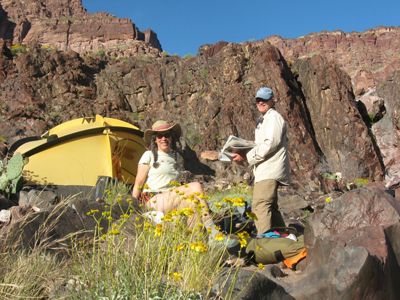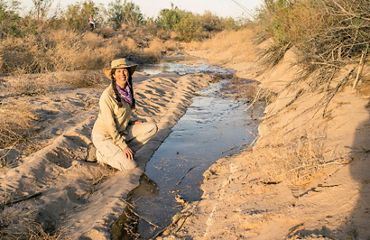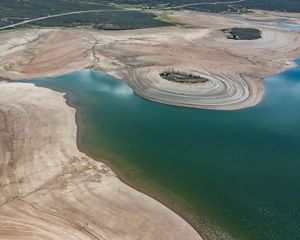
Working and Playing on the Colorado River
Conservancy Scientist Eloise Kendy describes the extraordinary experience of rafting through the Grand Canyon along the river she has worked so hard to protect.
By Eloise Kendy
As a high school student almost 40 years ago, I saved up enough money to go rafting down the Colorado River, through the Grand Canyon. That trip set my life’s trajectory. I became a geologist, hydrologist, environmentalist, and, not incidentally, a river rafter.
In 1997, one of my rafting buddies applied for a permit to float the Grand Canyon. It took 20 years, but he finally got the permit, and last month I joined him and 13 other friends for a 21-day trip of a lifetime.
Spending three weeks so intimately in tune with the Colorado River gave me pause to reflect upon The Nature Conservancy’s work there. What does it mean to conserve an ecosystem when that system is already stretched way too thin? The Colorado River’s 40 million municipal water users, 5 million acres of irrigated cropland and more than 4,000 megawatts of hydropower generation leave little room to maneuver, so we must choose our strategies wisely.

Plants and animals that live in and near rivers are adapted to natural variations in water flows. For instance, rising water levels are a cue to many fish that it’s time to spawn. And in rivers that flood seasonally, many tree species disperse their seeds in time to exploit the ample moisture available on floodplains. The whole river ecosystem is like a symphony that’s orchestrated with the rising and falling of water levels. When people change those natural water rhythms, the ecosystem begins to unravel. That is why the Conservancy’s Colorado River Program focuses on restoring natural streamflow patterns to the river and its tributaries.
But the Colorado River is a huge system. How do we decide where to invest our limited resources?
From an engineering perspective, the main function of the Grand Canyon reach is to convey water after it courses through the hydroturbines in Glen Canyon Dam. As a result, water levels in the river precipitously rise and fall daily, in absolute contrast to a natural river. The dam also controls flooding, so effectively that natural floods no longer occur. Instead of stately flood-dependent cottonwoods, the river is lined with shaggy, non-native tamarisks.
The dam operations also affect the 29,000 boaters who float the Grand Canyon annually. Without floods to redistribute rockfalls from the canyon walls, the rapids grow larger every year. While most rafters relish that challenge, no one likes hauling gear up steep sand cliffs from the river to camp. Because the dam retains sediment, the river no longer builds beaches along its banks. To compensate, dam managers occasionally release extra water just to rebuild lost beaches. But no sooner does that water recede, then the daily water level fluctuations eat away at the new beaches, carving out vertical cliffs.
Quote: Eloise Kendy

This project shows how stakeholders with diverse interests can come together to manage the river for people and nature in the face of drought.
Despite the obvious impacts of flow alteration in the Grand Canyon, currently there are few opportunities for the Conservancy to add to the ongoing efforts of a consortium of Federal and non-Federal partners to manage that reach. Moreover, there may be few opportunities to meaningfully restore flows, since so many people and institutions depend on keeping it the way it is.
In contrast, the Conservancy led a successful movement to restore natural flows to the Bill Williams River, a major tributary to the Colorado. By convening scientists and stakeholders, we convinced the operator of the river’s sole dam to change the timing of water releases to support natural systems, while still meeting its original objectives. Most river reaches fall somewhere between the Grand Canyon and the Bill Williams in terms of our ability to effect change. Unfortunately, ecological integrity is not always a top priority for most water managers. So, the Conservancy brings the river’s “voice” to multi-state and even bi-national solutions to high-priority problems.
For example, collaboration among multiple stakeholders was absolutely necessary in negotiating Minute 319, which redefined how the U.S. and México share Colorado River water and included provisions for environmental flows to the river’s delta. By setting clear restoration goals, contributing scientific expertise, working with local communities, and shouldering part of the financial burden for water acquisition, conservation organizations secured special dam releases to restore severely degraded delta habitat.
This returns us to the question: how does whole-system conservation apply to a working river like the Colorado? Clearly, there are some reaches, like the Grand Canyon, that we are unlikely to change. And there are others, like the Bill Williams, that readily serve as demonstrations of the future we envision. Between these two extremes lies most of the river basin, where we have learned that by working in partnership with larger water users, we can make progress at ambitious scales.

